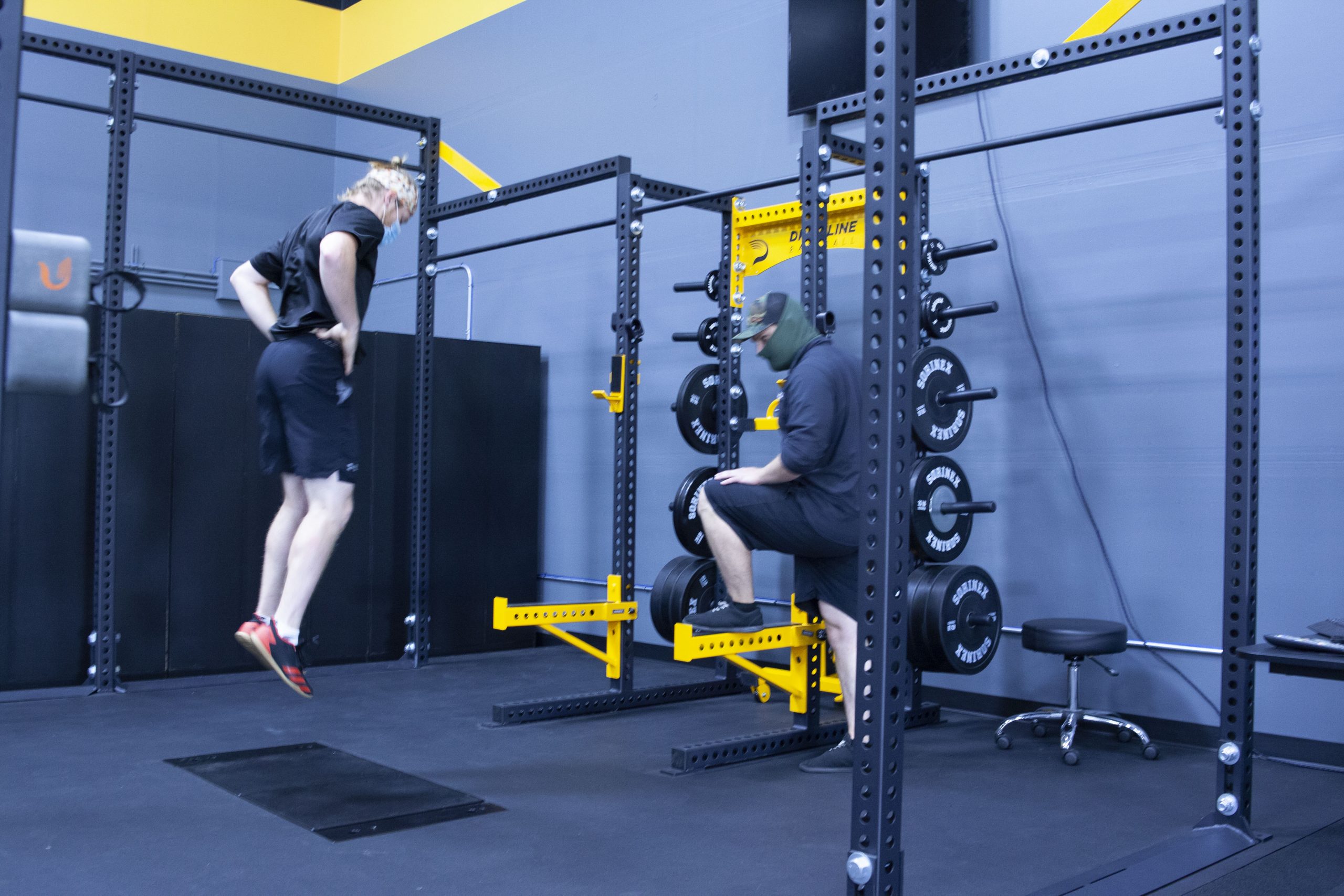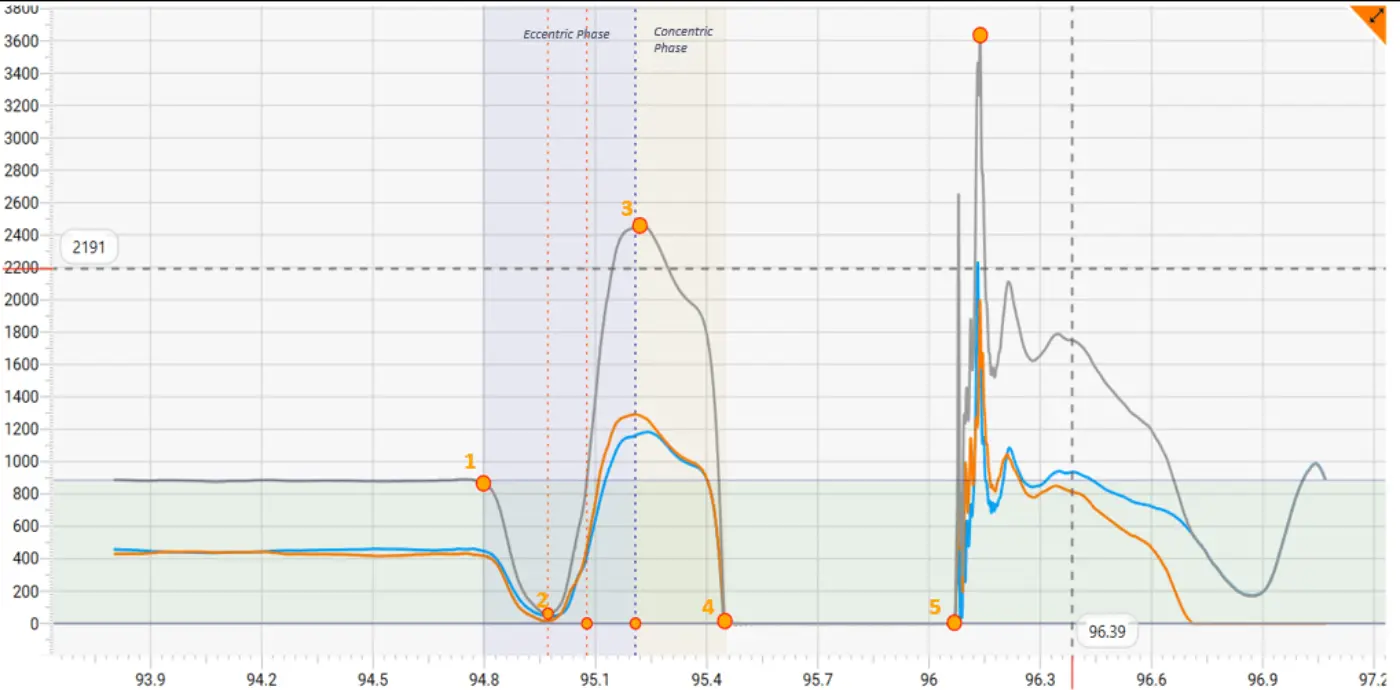What is the Countermovement Jump (CMJ) Test?

If you haven’t read our High Performance assessment summary blog, it is a good place to start.
The Countermovement Jump (CMJ) is a vertical jump test performed by having an athlete quickly squat to a self-selected depth and then jump as high as possible. It is the first jump in our force plate assessment and is used to both determine lower body power via jump height and to measure lower limb asymmetries.
Our Protocol
- Weigh the athlete.
- Tell the athlete: “Hands on hips.”
- Say: “When I say go, jump straight up as high as you can.”
- Take 10 seconds rest in between jumps.
- Do 4 jumps (outliers and mistrials are removed).
Why We Do it this Way
A CMJ can be performed with the athlete’s natural arm swing or with hands placed on hips. We use hands on hips because every athlete can generate a different amount of power from their arm swing, making comparison between athletes less reliable with an arm swing [1].
An efficient arm swing can have a significant impact on jump height when compared to an inefficient arm swing, so by using the hands-on-hips variation, we eliminate differences in jump performance that are strictly due to arm swing, thus giving us a more precise representation of lower body power.
Measuring the Counter Movement Jumps
When it comes to measuring jump performance on a dual force plate system, the most common strategies are to estimate jump height using either flight time or using a calculation based on the athlete’s change in momentum (imMotus) to estimate their center of mass displacement.
One flaw in using flight time to estimate jump performance is that a jumper often will not land in the same body position that they left the ground in, causing flight time to overestimate their center of mass displacement if they land in any posture other than their upright takeoff position [2]. The imMotus-momentum method’s main source of error comes from imprecise measurement of the athlete’s weight, which is easily avoided by frequently calibrating the platform in order to minimize drift and by ensuring that the athlete stands still while being weighed.
In an assessment setting, we want to make sure we are getting an accurate evaluation of an athlete’s relevant capabilities, which is why our CMJ assessment is performed with hands-on-hips and measured using imMotus-momentum estimated jump height.
Lower-Limb Asymmetries
Monitoring asymmetries in lower limbs is another application of the CMJ. Athletes who demonstrate >15% eccentric asymmetry have been linked to higher risk of lower body injury, but measuring asymmetries isn’t necessarily about injury prediction—it is mainly used to improve programming and as a framework for monitoring both the general athlete population and those undergoing return-to-play protocols [3].
Force plate researcher Matt Jordan found that athletes with relatively clean lower body injury history showed no significant asymmetry patterns over time, while those with ACL injury history exhibited a pattern in their asymmetries, along with a higher degree of asymmetry.
These patterns showed an athlete consistently favoring the same leg during the same phases of the jump across multiple trials. Not every athlete with ACL injury history displayed the same asymmetry patterns, but the presence of any pattern within one athlete’s trials was well correlated with injury history [3].
Athlete Asymmetry Context
Athlete 1: Has a tight right hip from a previous injury, causing them to have trouble squatting into their right side, resulting in them favoring their left side in the eccentric portion of the jump.
Athlete 2: Favors the left leg due to a previous right-side ACL injury.
Percentage-wise, both athletes could show the same results with significantly different underlying causes. This is why it is important to understand the context behind asymmetry index percentages.
Another reason to look beyond the percentage readout: a study testing athlete lower limb asymmetry in the CMJ, Squat Jump, Isometric Mid-Thigh Pull, and Drop Jump Tests found that asymmetries were task-dependent [4]. Considering this alongside the demands of on-field tasks, instead of predicting injury the CMJ asymmetry results tell us to investigate the causes that could impact the athlete’s health and performance.
Data Interpretation
When it comes to interpreting an athlete’s force plate assessment data for the CMJ, we start by looking at the outcome measures—jump height and asymmetries in various phases of the jump.
This gives us a surface level understanding of the athlete’s lower body power capabilities and allows us to identify potential red flags in their movement strategy. However, when necessary we can dive deeper—looking at eccentric & concentric contraction times, countermovement depth, lower limb stiffness, RSI-mod, and other metrics that provide more information about how the athlete produced the outcome measures.
Jump height is compared to our facility data, normed specifically to their level of play (high school, college, MiLB, etc.), and used along with their squat jumps, hop test, and isometric mid-thigh pull results to inform their next phase of strength programming.
Asymmetries are expected, and may even be advantageous—for example a pitcher developing greater external rotation in their throwing shoulder. However, anecdotally, we’ve found that high asymmetries greater than 20-25% generally indicate an existing injury or evidence of a past injury, where the athlete may not have recovered full function of the affected limb. Some studies have shown increased injury occurrence in athletes displaying asymmetries greater than 15% [3].
Therefore, we will typically intervene with targeted strength programming when we see a consistent pattern of asymmetries that approaches 15% or higher. Some ways that we address asymmetries is to substitute more single leg and unilateral strength exercises (e.g. reverse lunges & single-leg RDLs) for bilateral lifts (eg. squats & deadlifts) in order to ensure that each limb is receiving the appropriate training stimulus in each training session. We can also target specific phases of movement; if an athlete has a pronounced asymmetry in the eccentric deceleration phase of their CMJ, we can target deceleration patterns and eccentric strength with our programming to build those capacities in the affected limb.
We also look at the force trace resulting from the jump to provide further context to their test results. Here is an example CMJ force-trace with key stages in the jump highlighted:

Key Force-Trace Points:
- Start of the jump
- End of underloading
- End of the eccentric phase
- End of the concentric phase (takeoff)
- Landing
Additional things to focus on when looking at a CMJ force-trace are a stable initiation and the right and left leg individual traces. The grey line is the trace of the total force, with orange representing the right side and blue the left side. The individual leg traces can give further context to the asymmetry percentages, helping to inform program adjustments and return to play procedure.
How We Counter Movement Jump Data
After an athlete completes their force plate assessment, we use the data from their CMJ, squat jump, hop test, and isometric mid-thigh pull together to determine their strength program needs.
The CMJ results can be used in conjunction with the Isometric Mid-Thigh Pull to inform the athlete’s next training block. With the CMJ demonstrating lower body power and the IMTP measuring more absolute strength, the balance between the two gives us a complete picture of their needs.
An athlete who outperforms the average of their competition level in the CMJ but is lacking in IMTP force production may benefit from a strength-focused training phase, while an athlete who demonstrates above-average strength in the IMTP but a below-average jump height might need a power-focused phase for their next block.
We generally build strength first, developing the athlete’s ability to produce high forces, and then add power, increasing the rate at which they can exert those high forces. This is not always the case, with time of season, athlete age, training experience, positional needs, and other factors also influencing what they need. Stage of competition is especially important to consider, and we will typically have athletes that are in a late off-season period do more ballistic work, such sprints and plyometrics, to prepare for competition.
The ratio of the squat jump height to CMJ height tells us how much jump height the athlete gains from the countermovement in the jump. We use CMJ height divided by SJ height to get an eccentric utilization ratio. We look for this to be between 1.1-1.20, or in other words a 10-20% higher CMJ height than SJ height.
An athlete who scores below 1.1 may benefit from exercises that include the stretch-shortening cycle (SSC), such as a countermovement trap bar jump or hang-variation Olympic lifts. For athletes that score >1.2, the opposite focus may be needed, implementing concentric focused lifts like a trap bar jump from the ground or Olympic lifts from the ground.
These are not absolutes as other variables affect jump height in either jump, and variances in an athlete’s jump technique could be more to blame for their score than their usage of the SSC, so it is important to view the 1.1-1.2 window as a guideline and not a rule.
The data from all force plate tests are used to inform athlete programming and measure their progress throughout their training. This data is always taken in the context of their training history, current throwing phase, whether they are in season or not, and a variety of other variables that influence their needs.
By Dan Adams, Connor White, Daniel Comstock, Connor Rooney, High Performance
[1] Markovic G, Dizdar D, Jukic I, Cardinale M. “Reliability and factorial validity of squat and countermovement jump tests”. J Strength Cond Res. 2004; 18 (3): 551–555.
[2] Linthorne, Nicholas P. “Analysis of Standing Vertical Jumps Using a Force Platform”. American Journal of Physics, vol. 69, no. 11, 8 May 2001, pp. 1198–1204, doi:10.1119/1.1397460.
[3] Jordan, Matt. “Assessing Mechanical Muscle Function in Athletes: Jump Asymmetry and Performance Assessments with Dual Force Plates.” Jordan Strength, 2019.
[4]Wells, Jack & Mitchell, Andrew & Charalambous, Laura & Fletcher, Iain. (2018). “Relationships between highly skilled golfers’ club head velocity and force producing capabilities during vertical jumps and an isometric mid-thigh pull”. Journal of Sports Sciences. 36. 1-5. 10.1080/02640414.2018.1423611.
Comment section